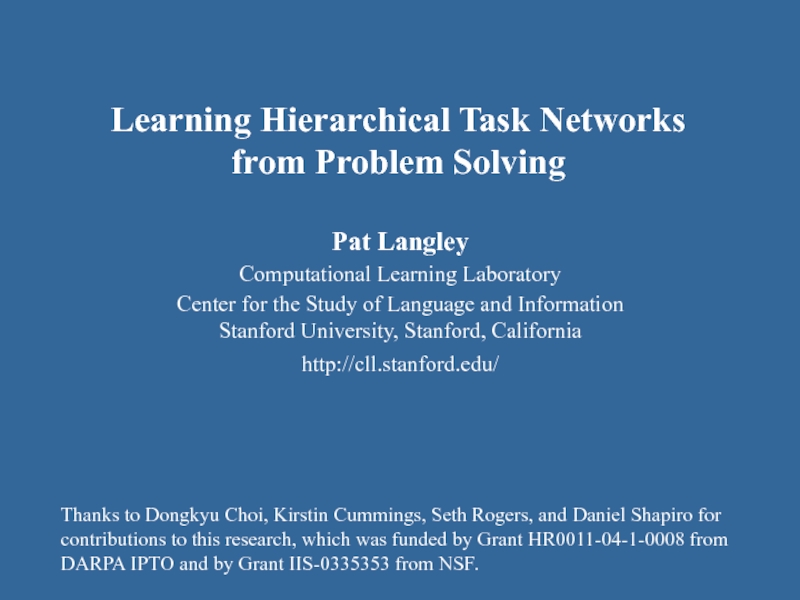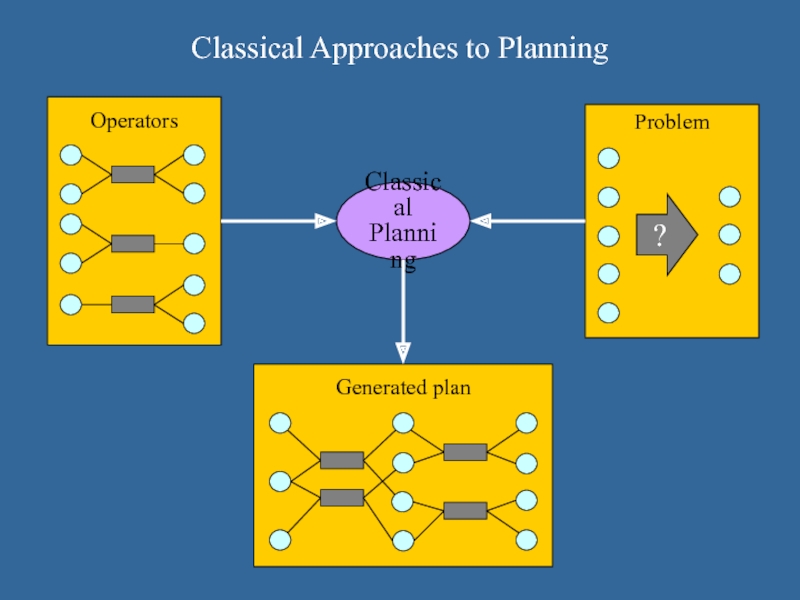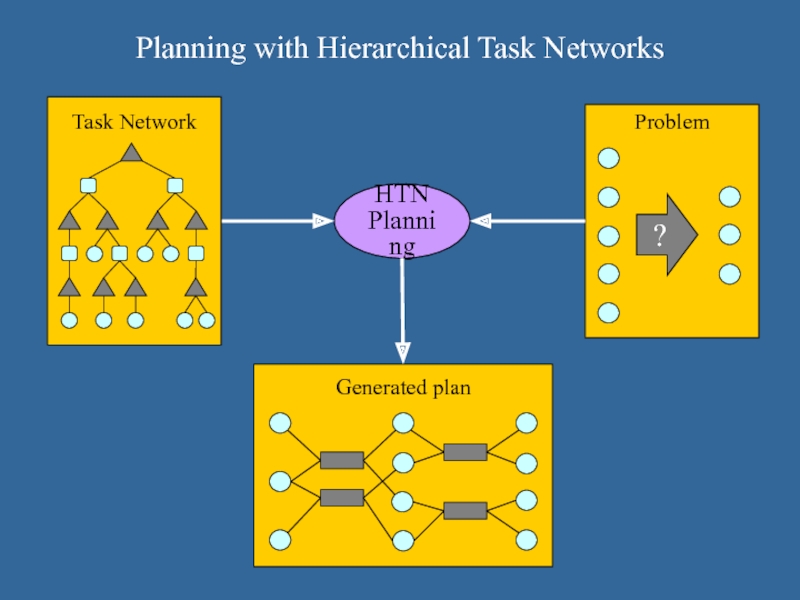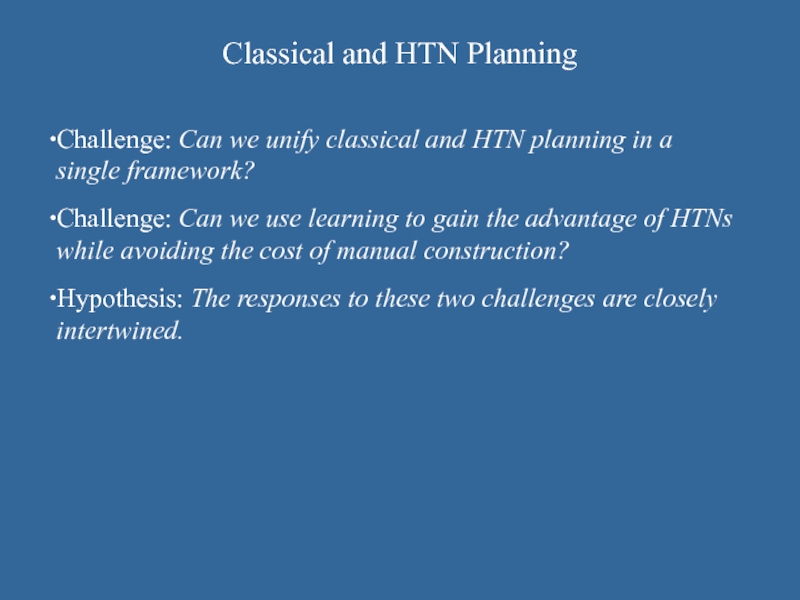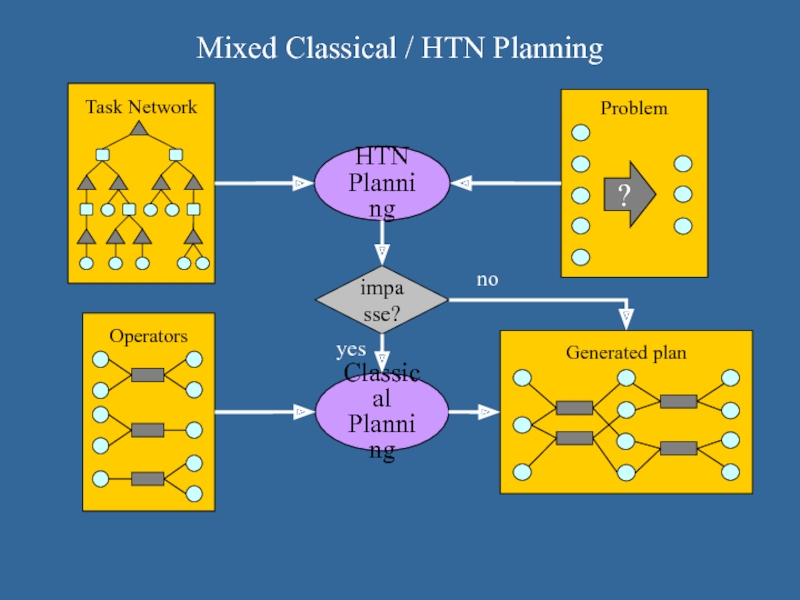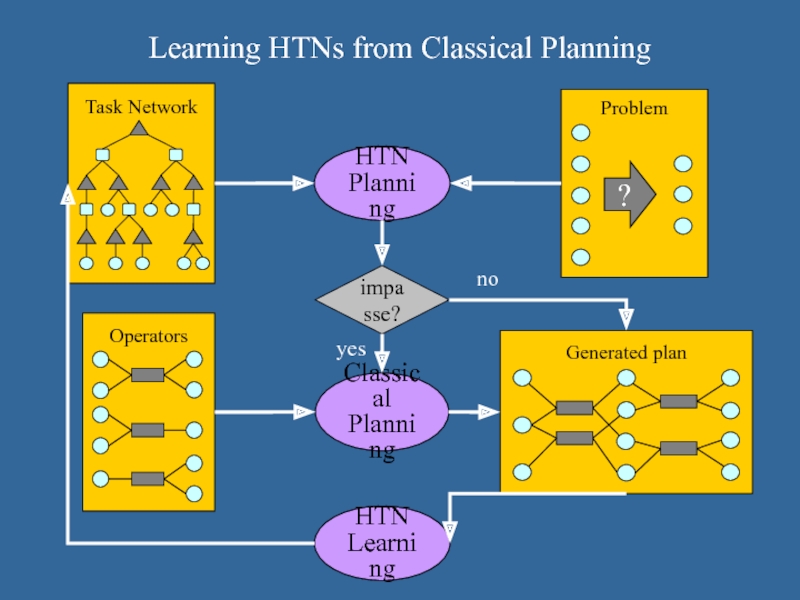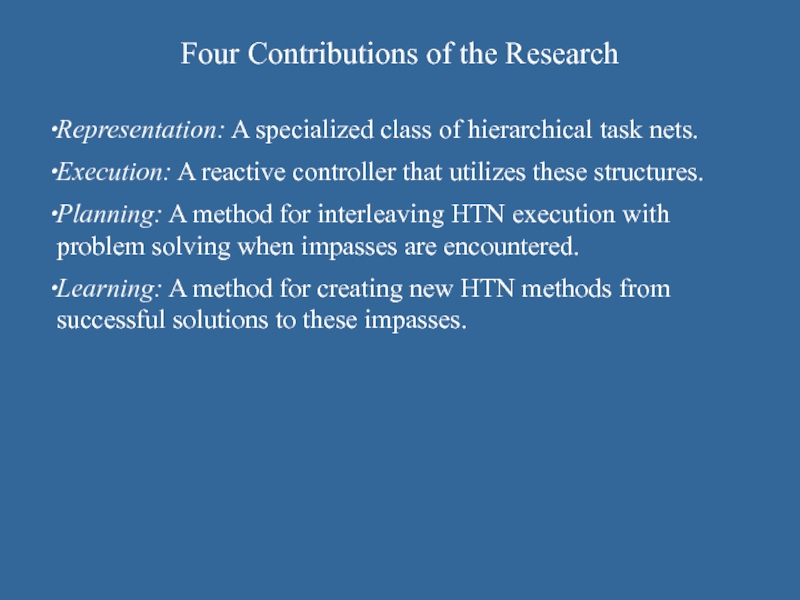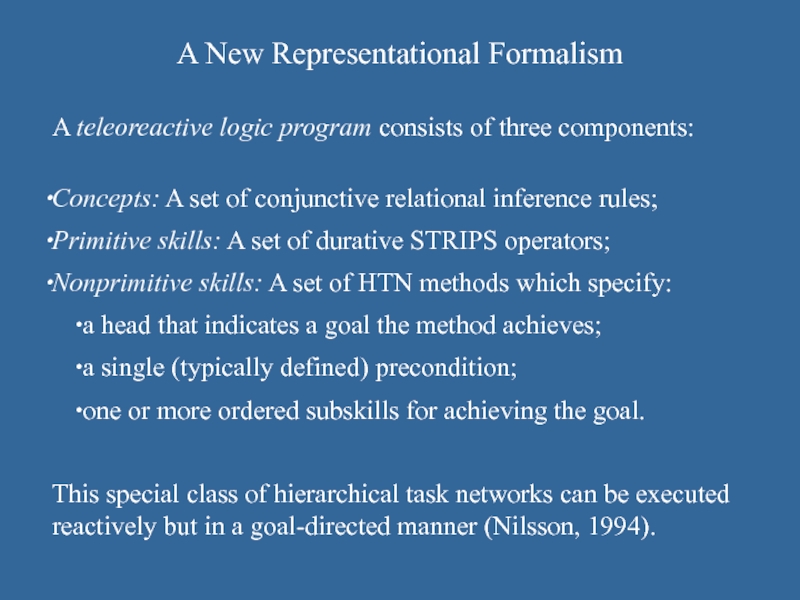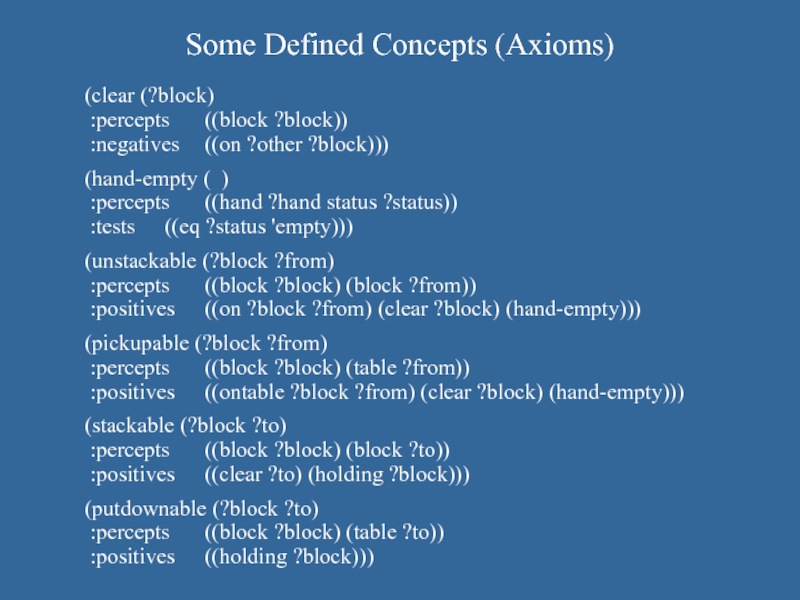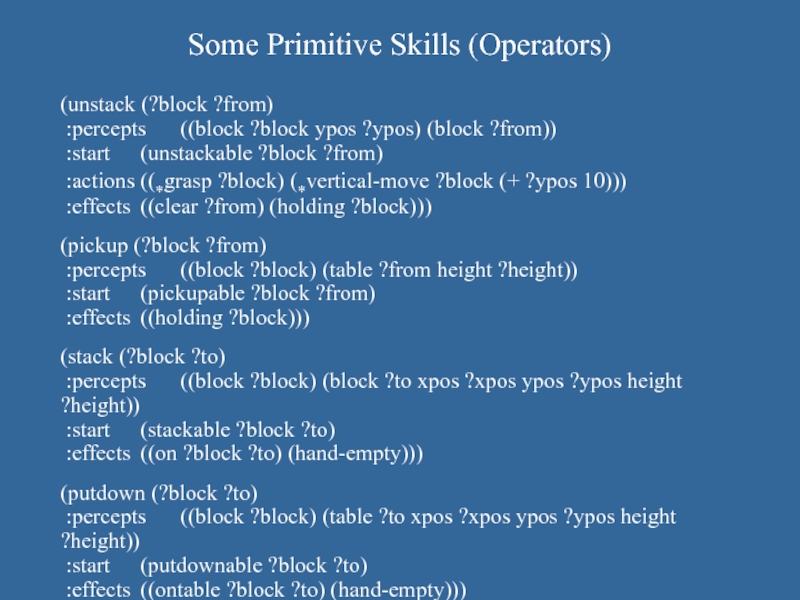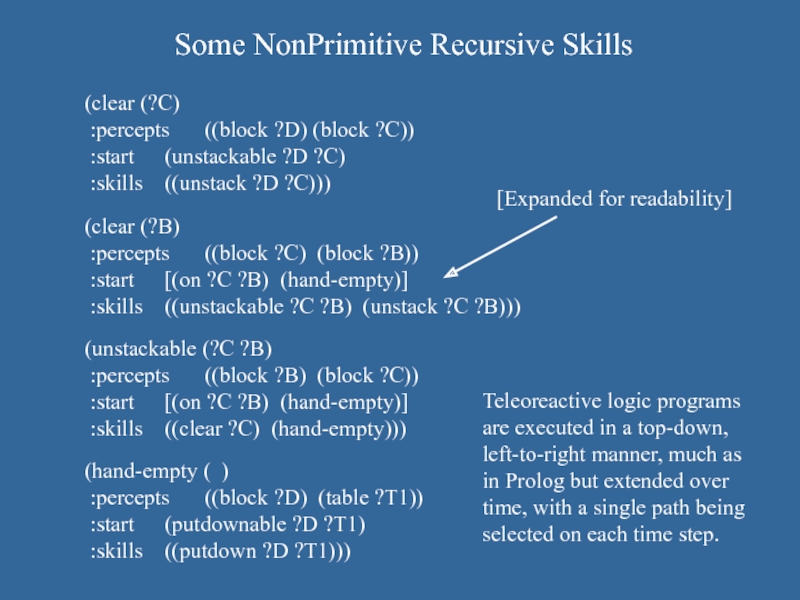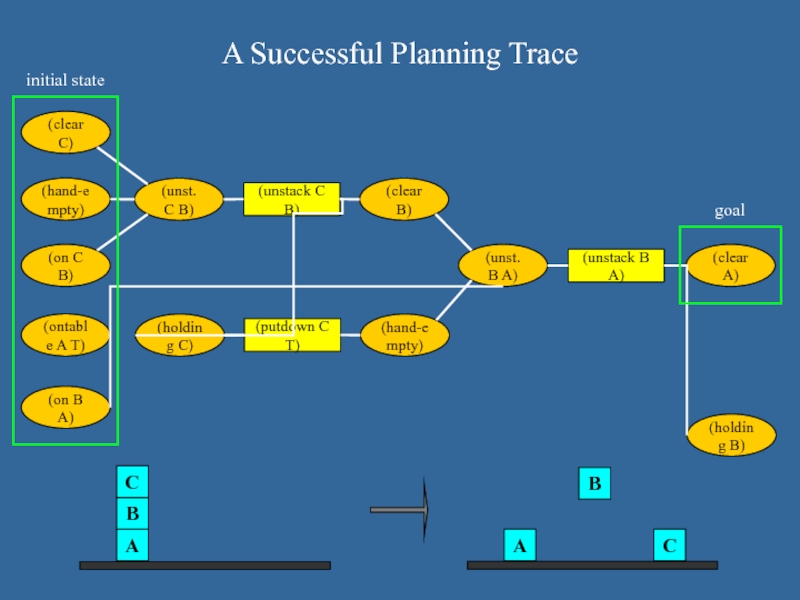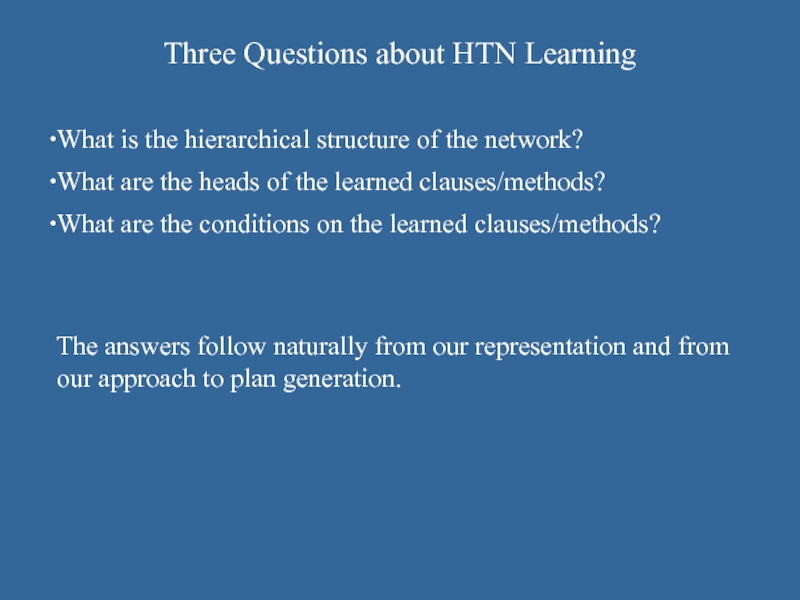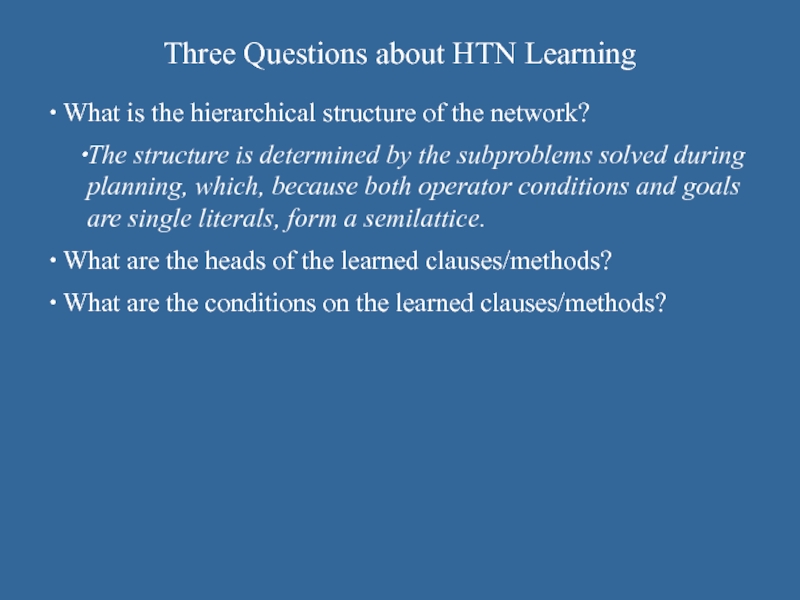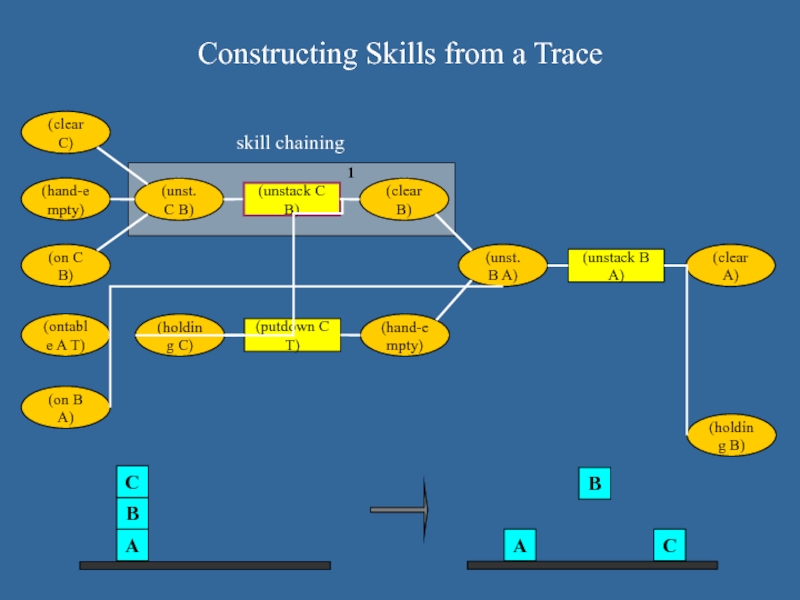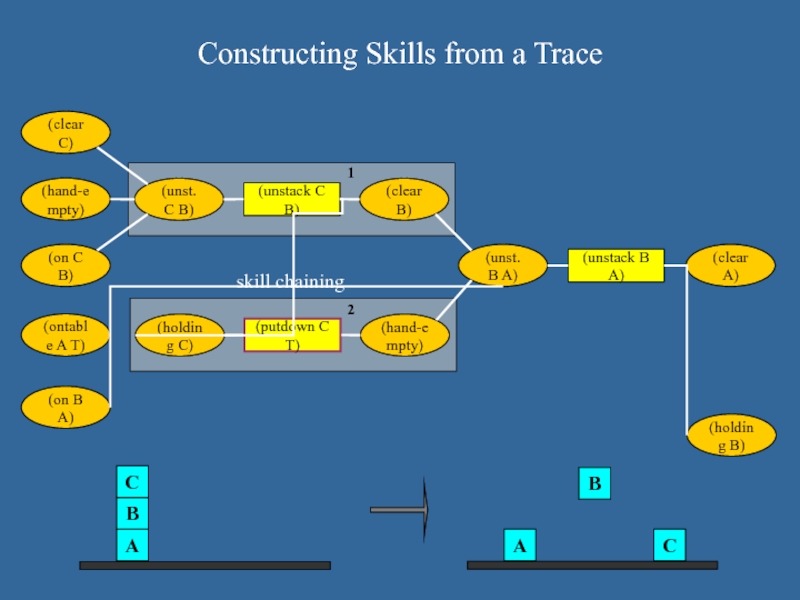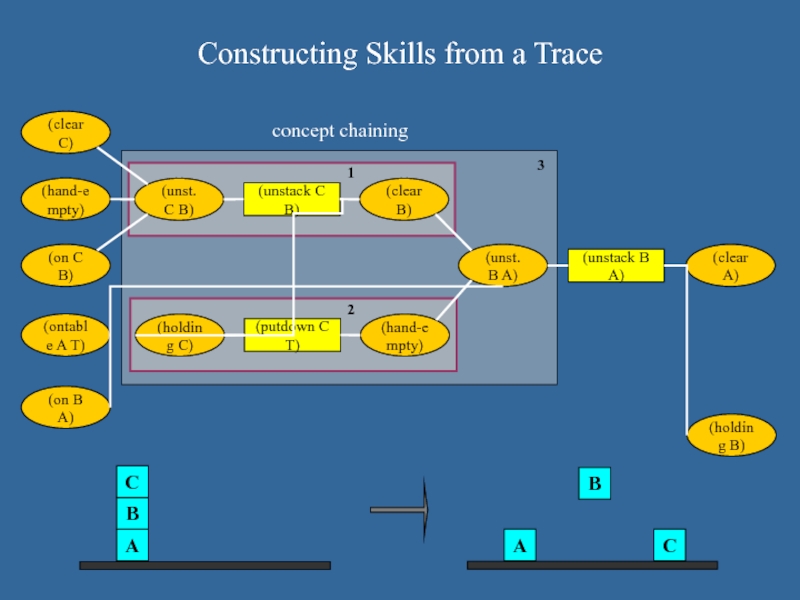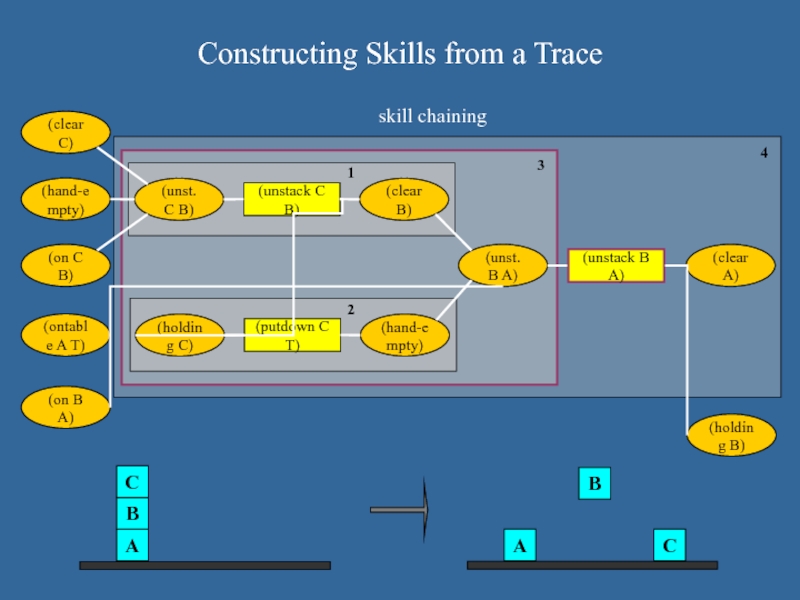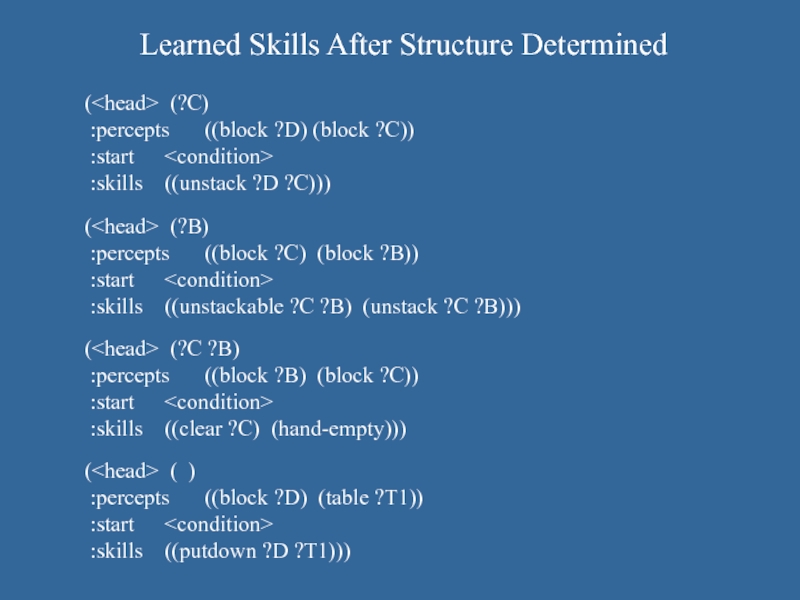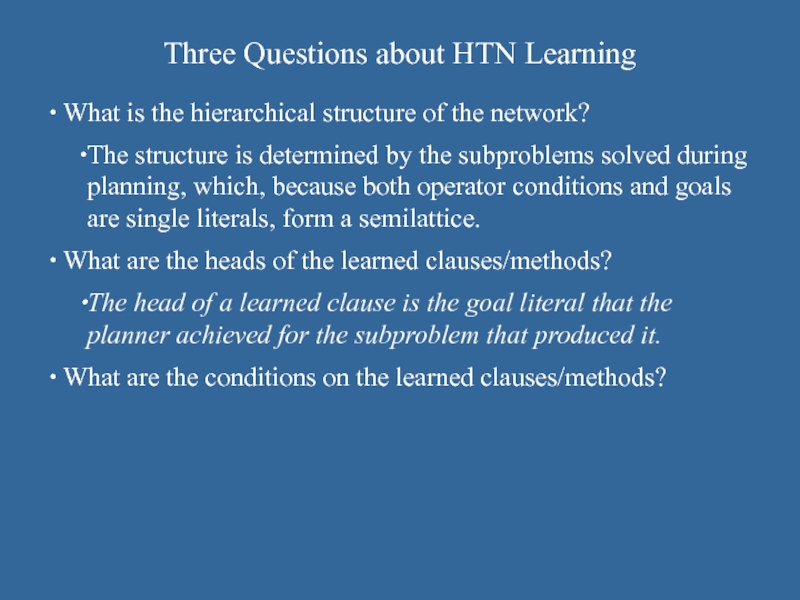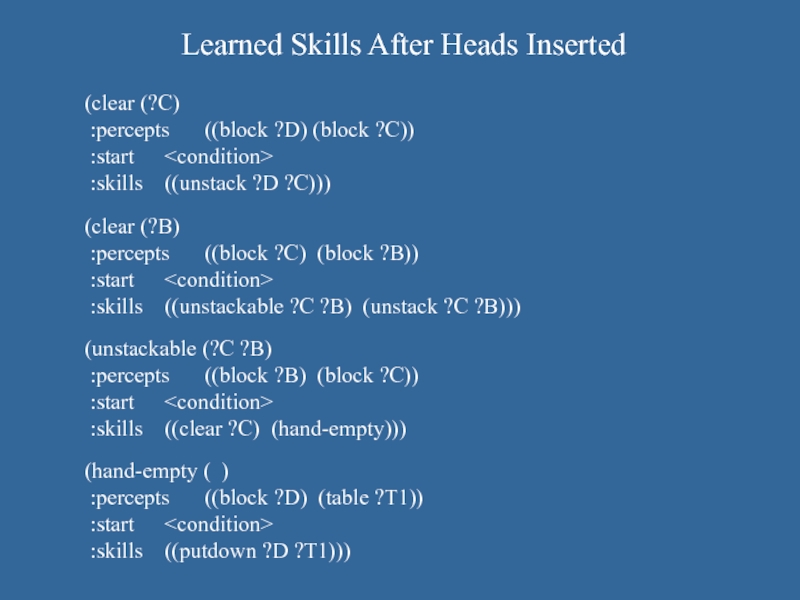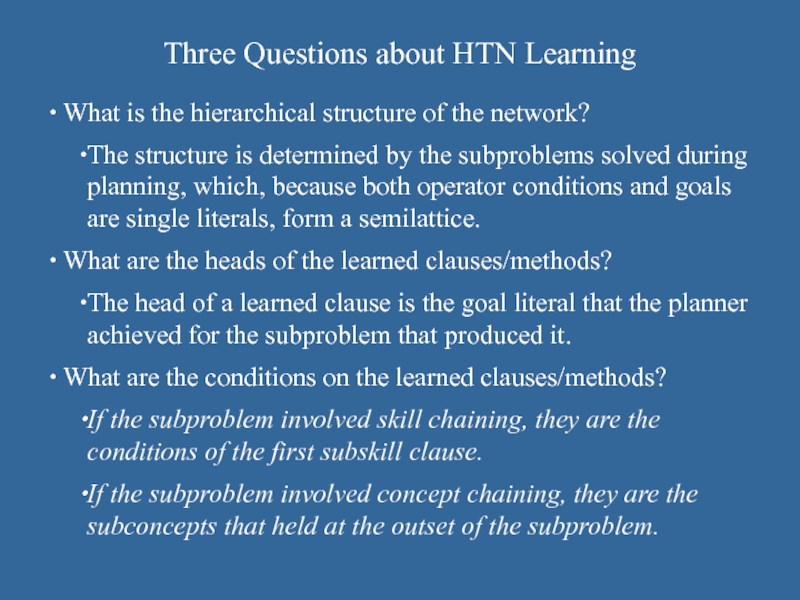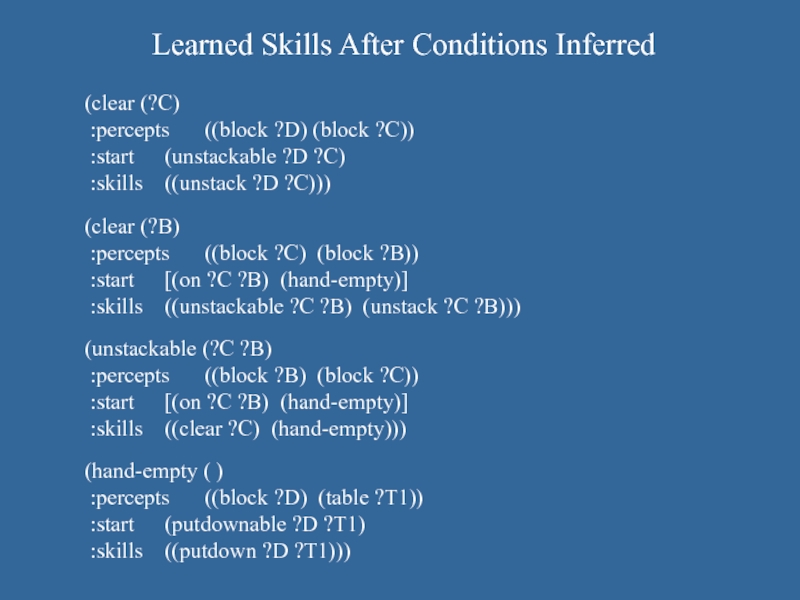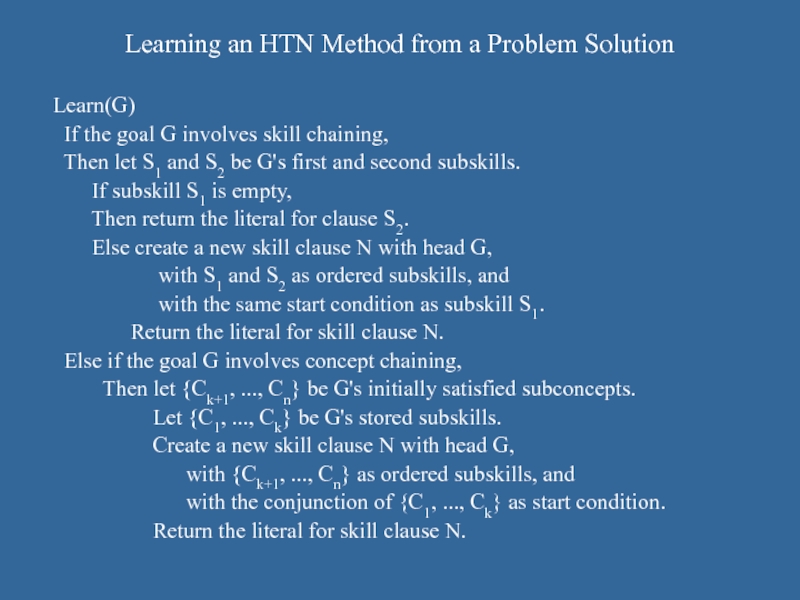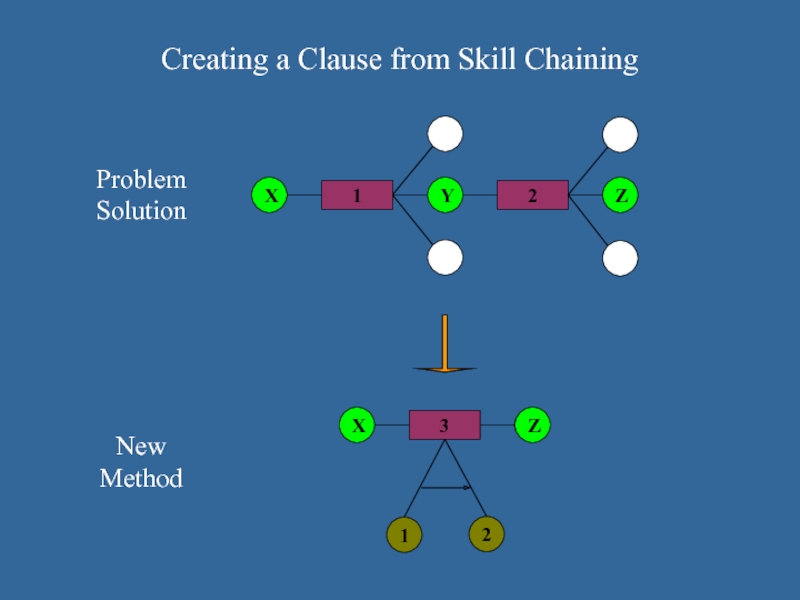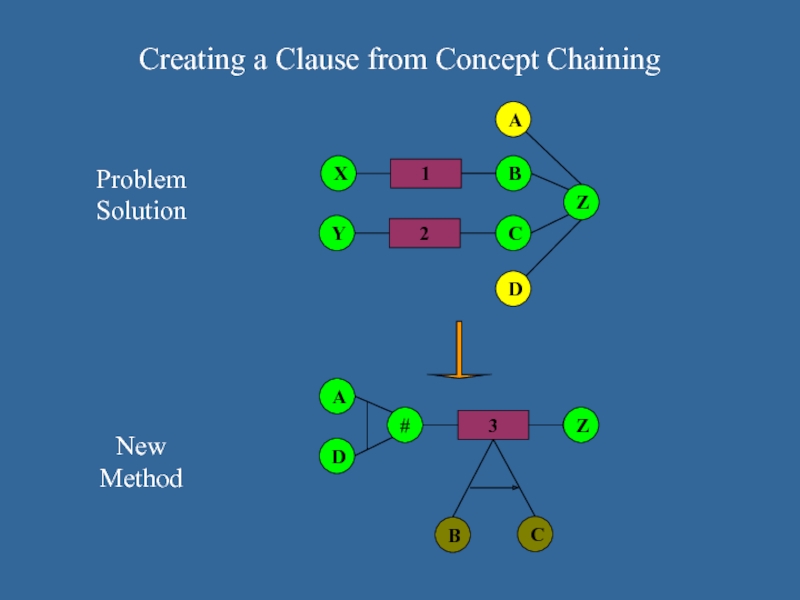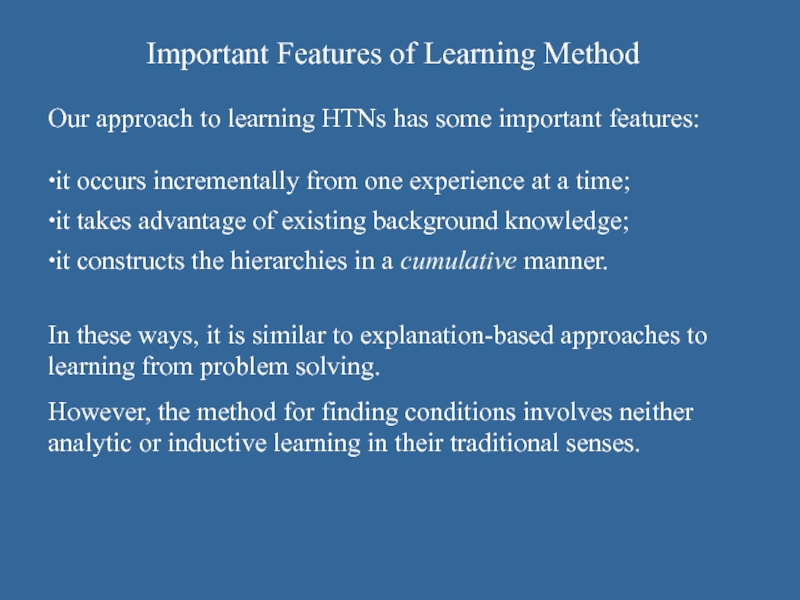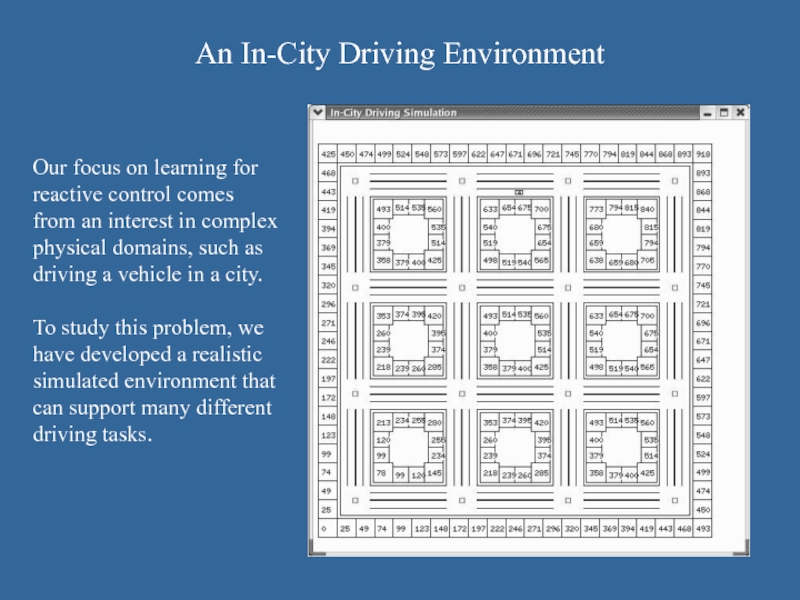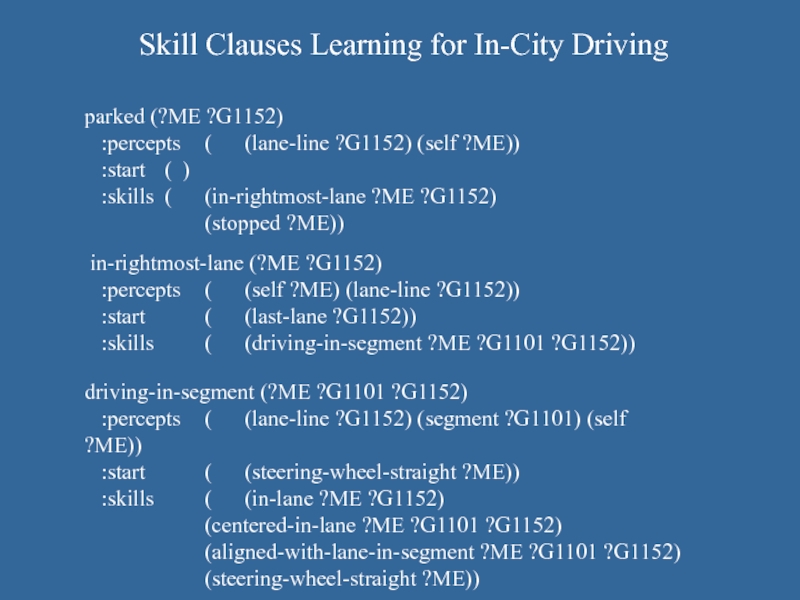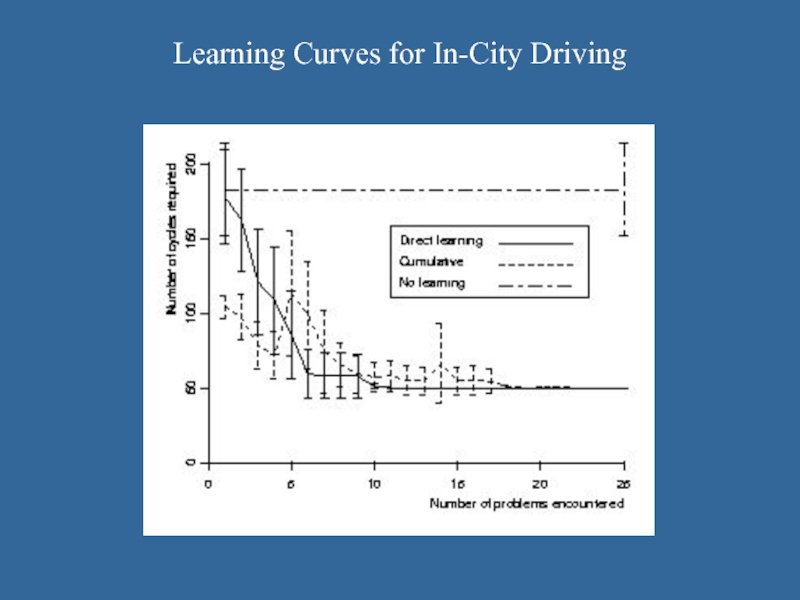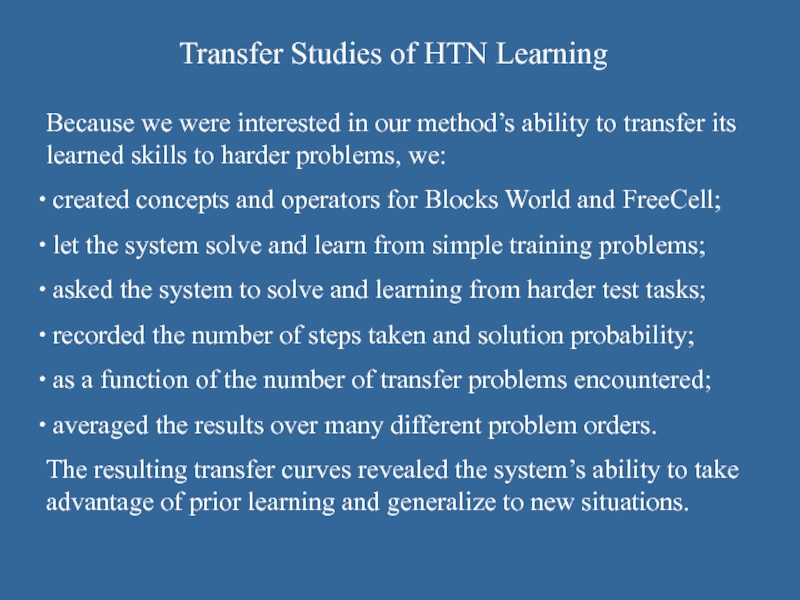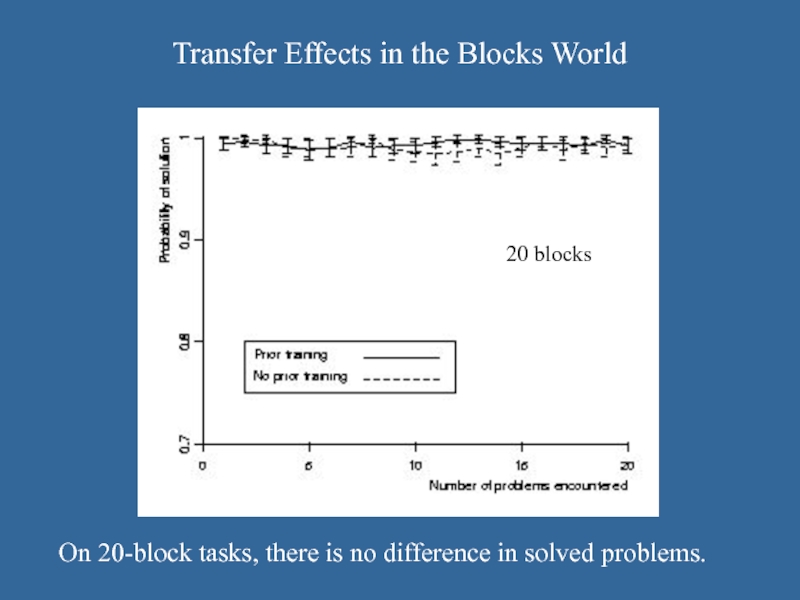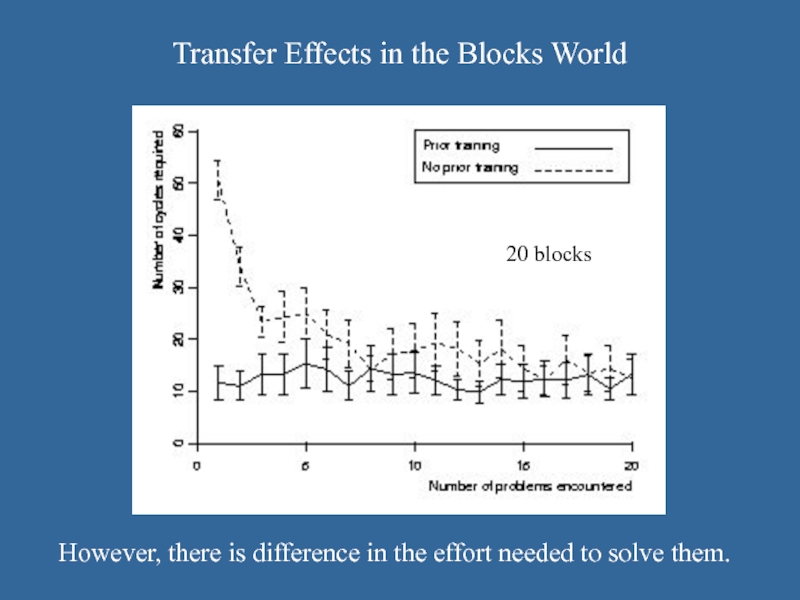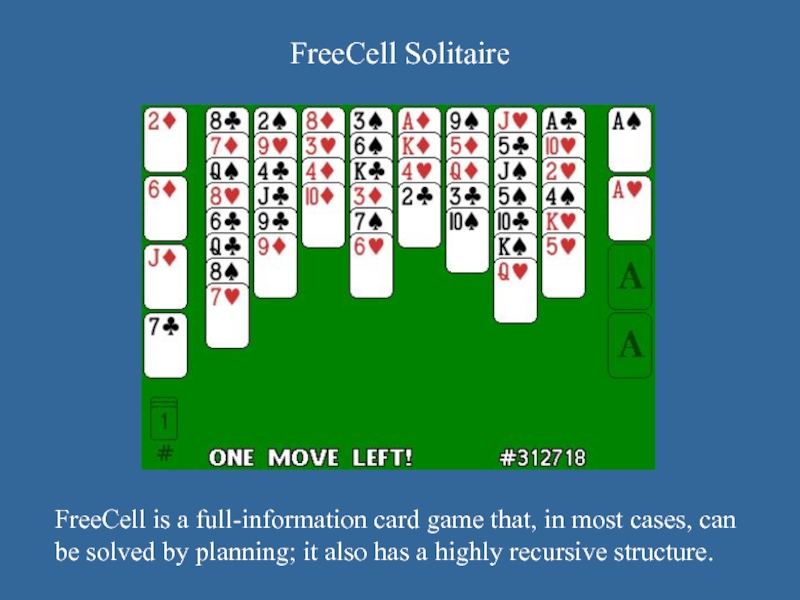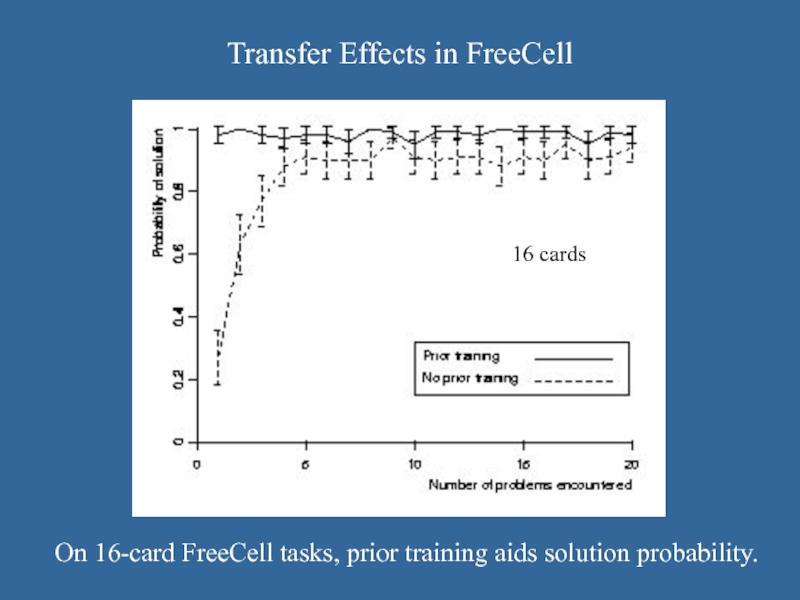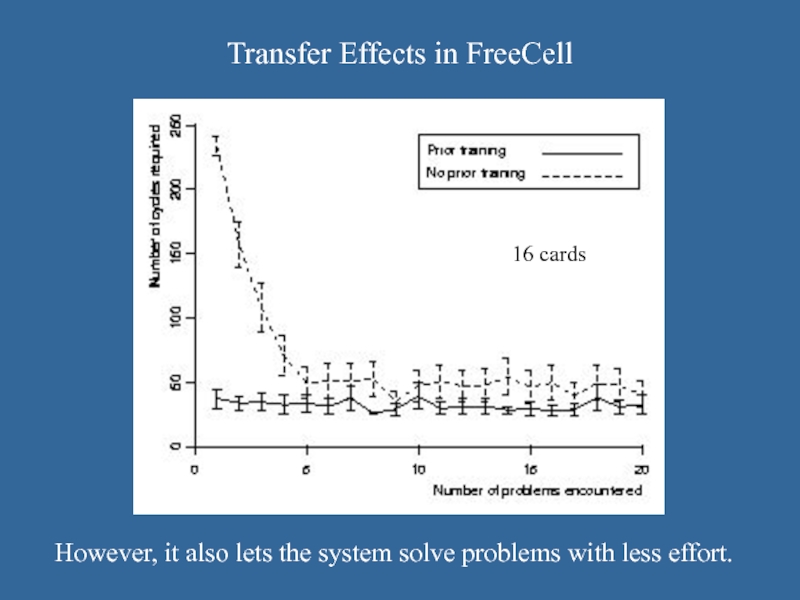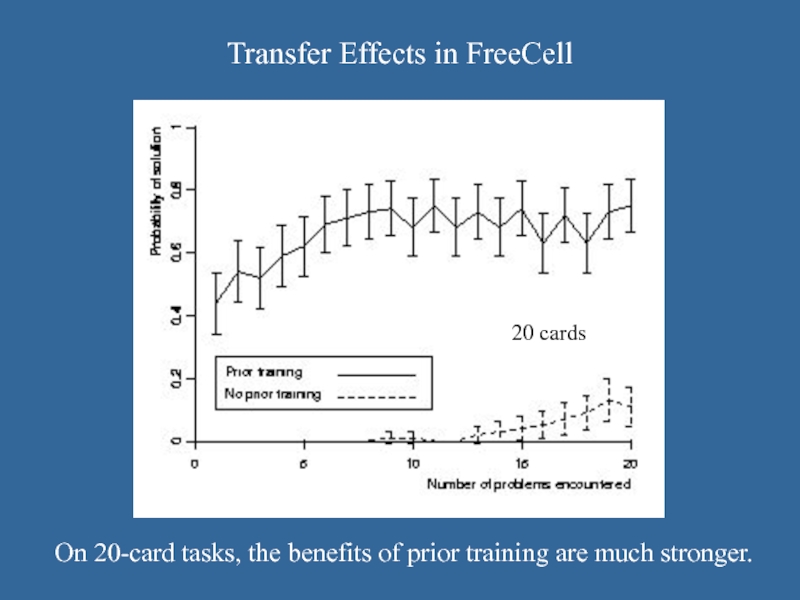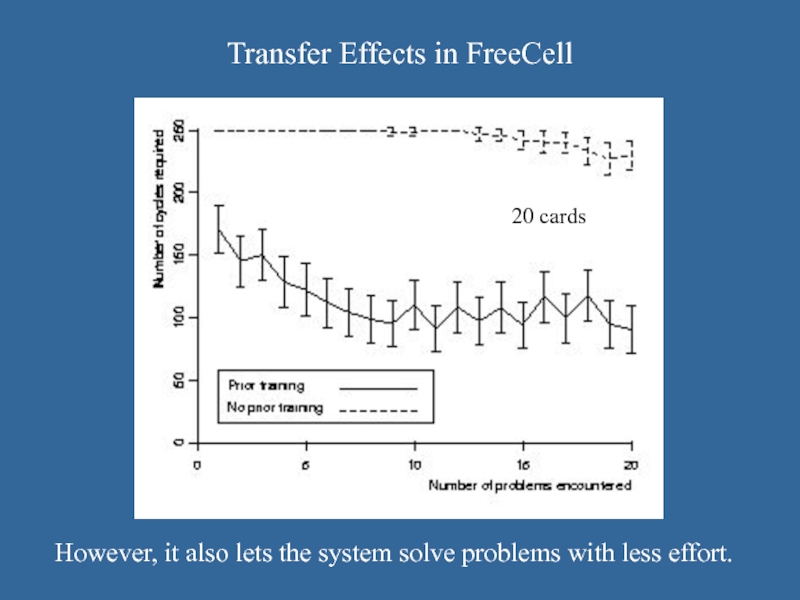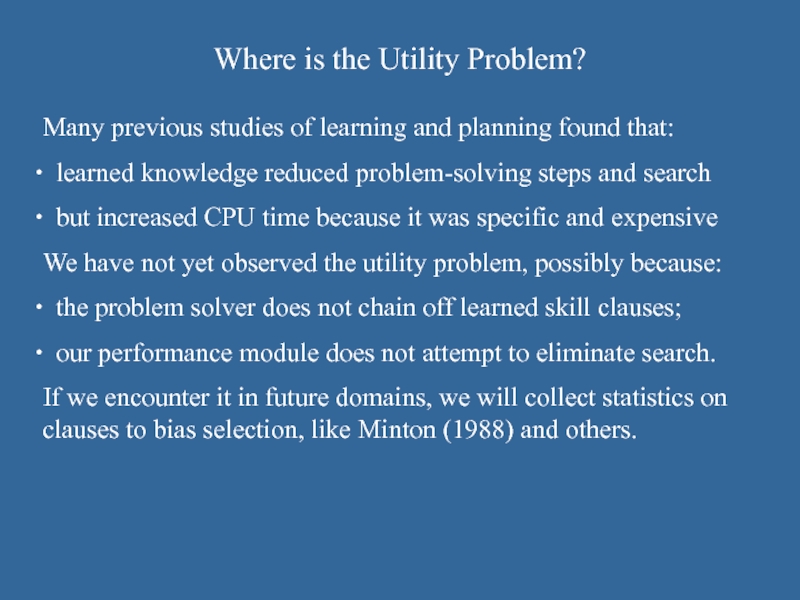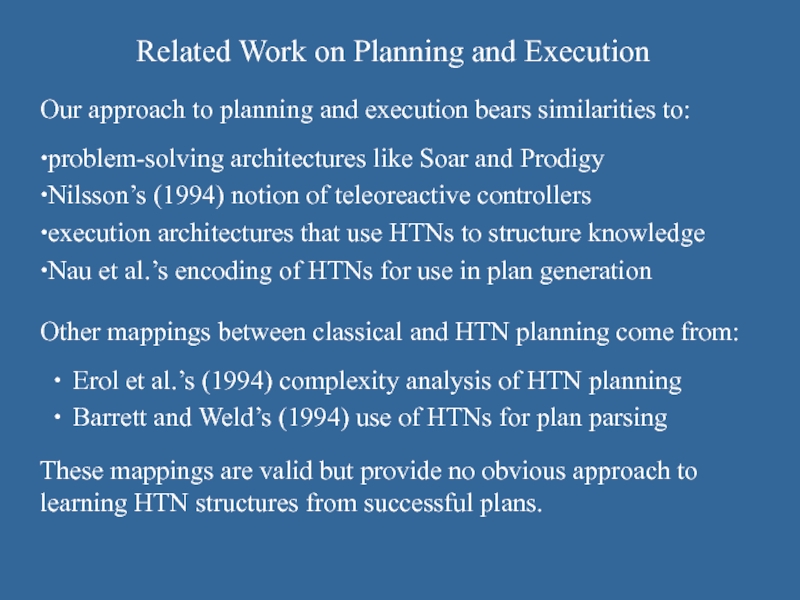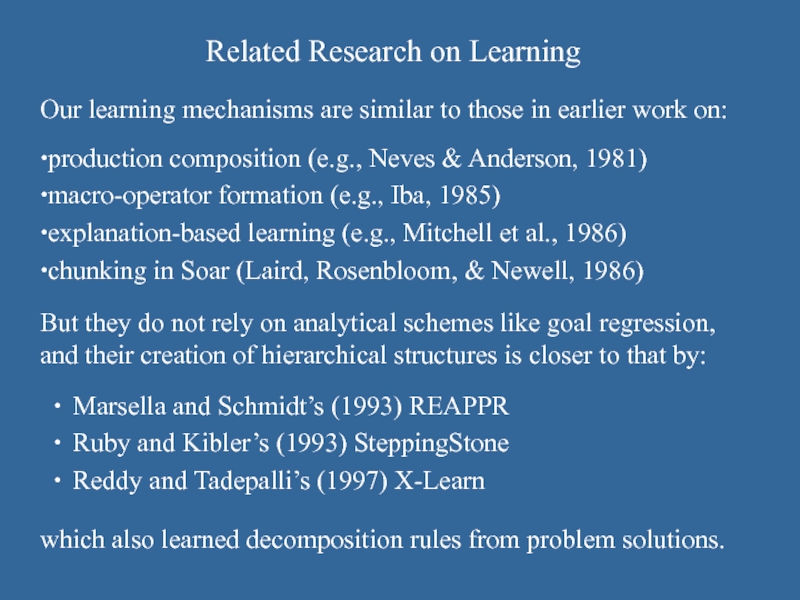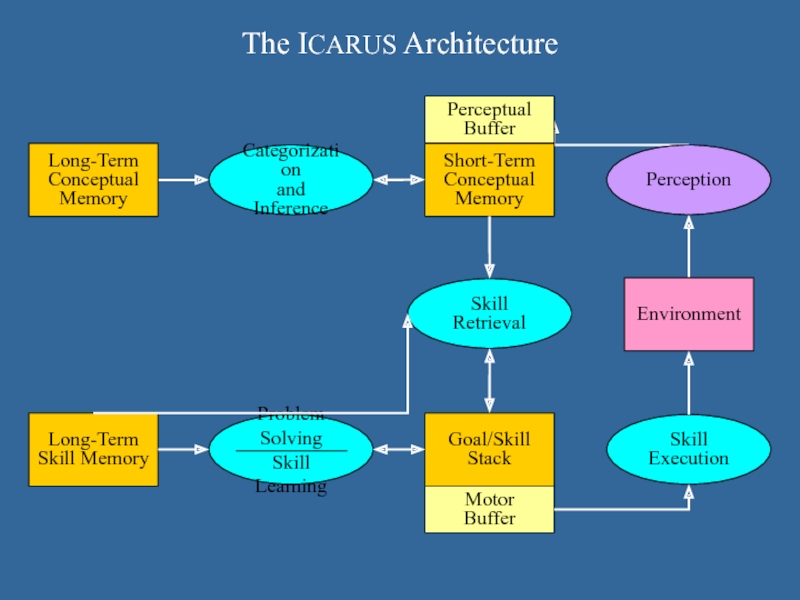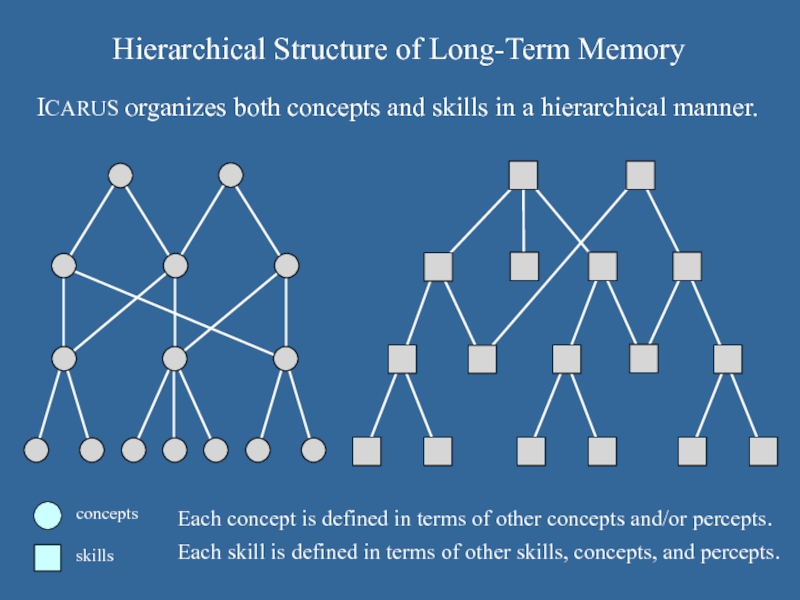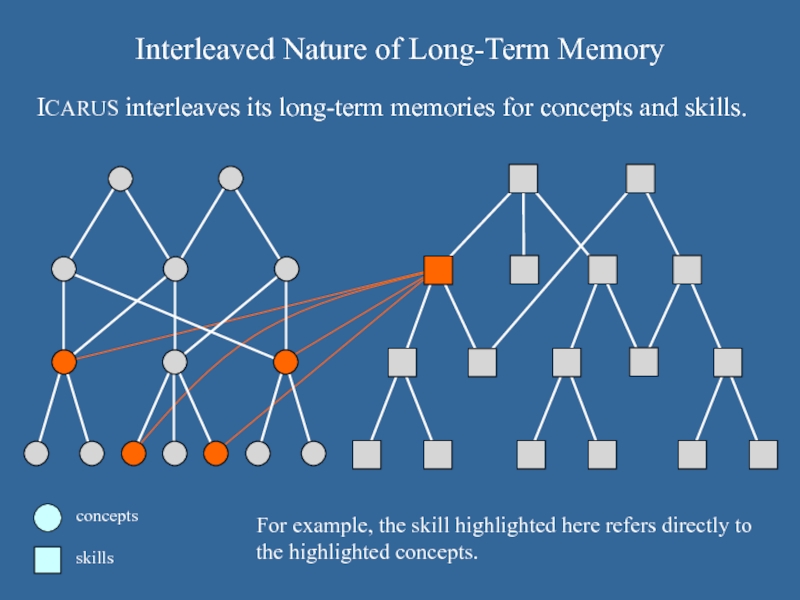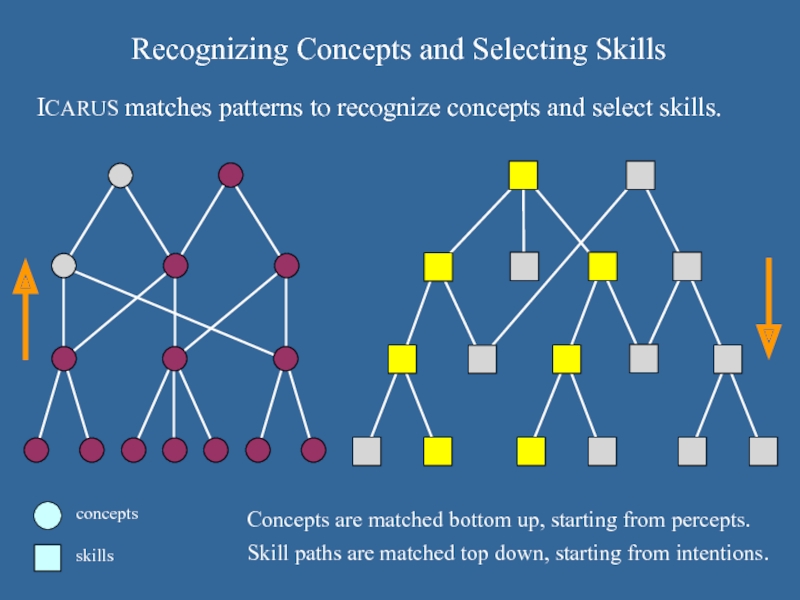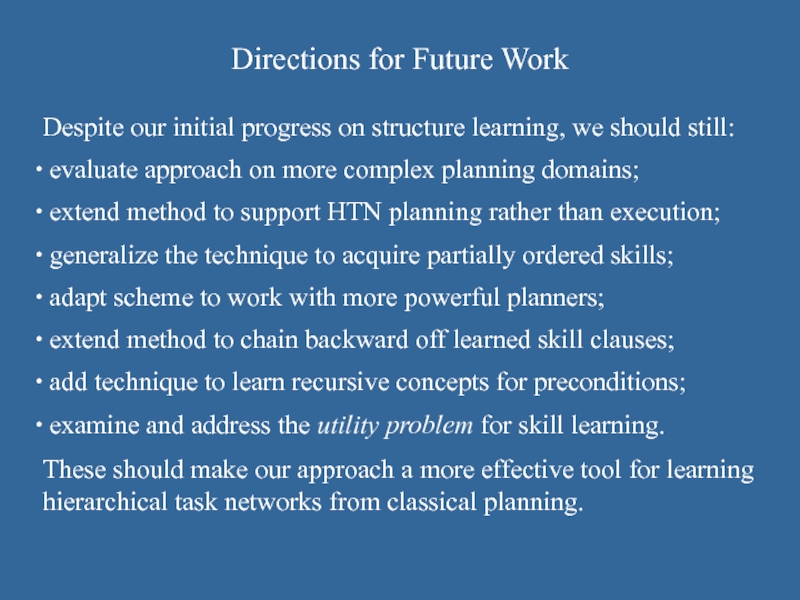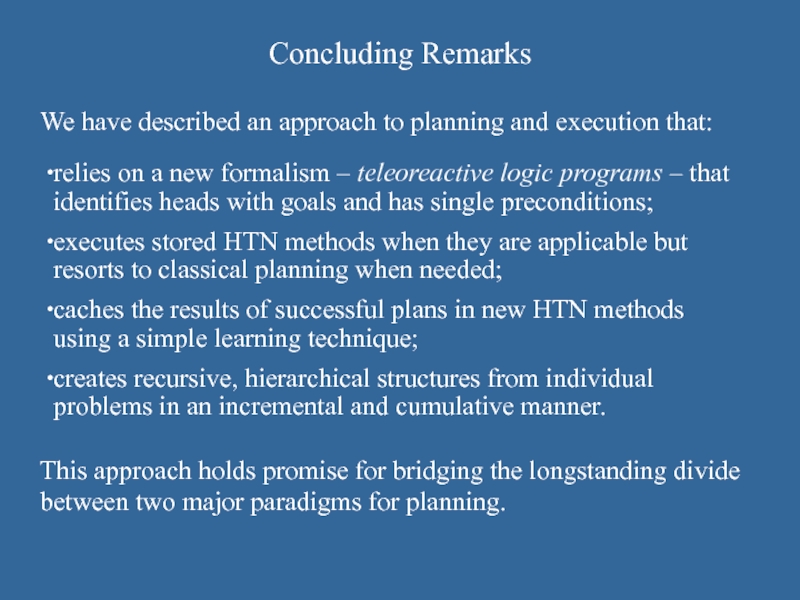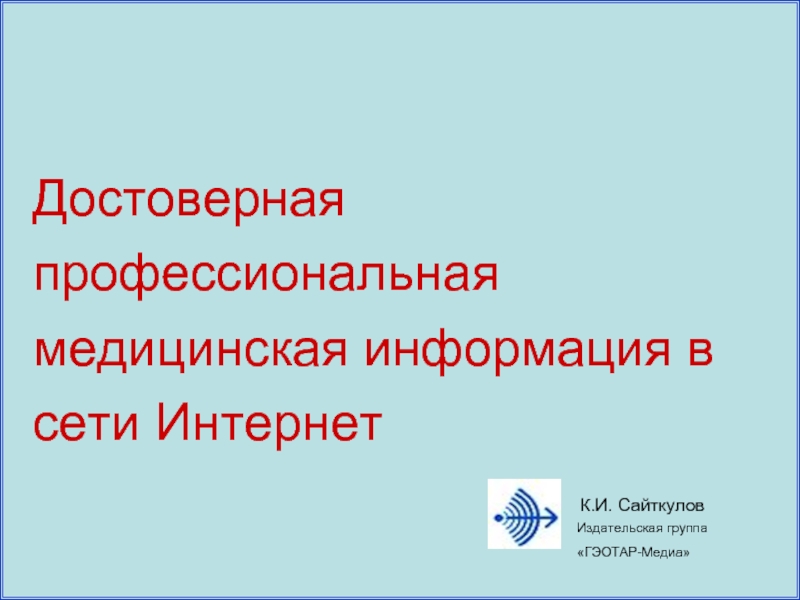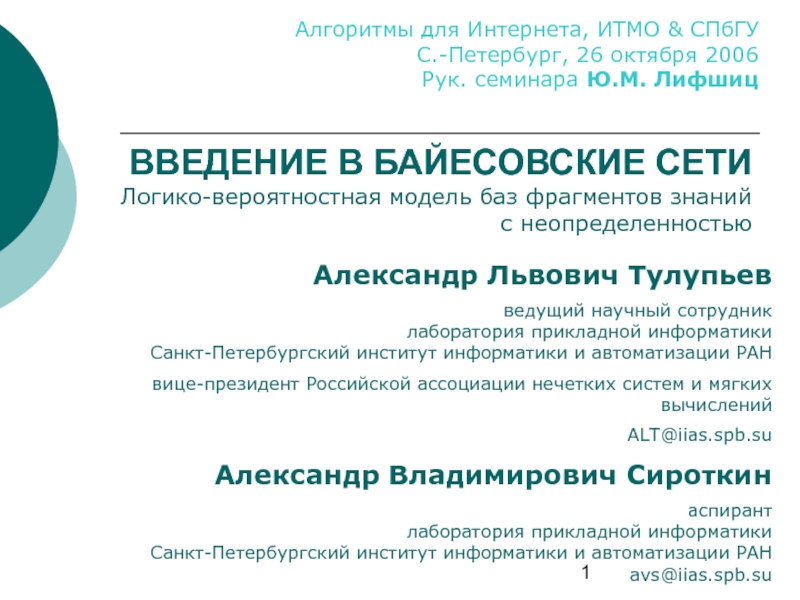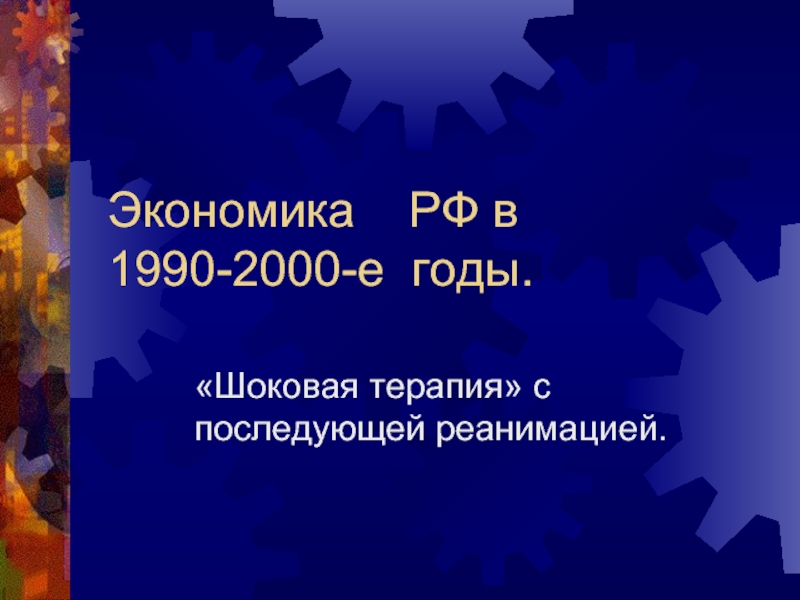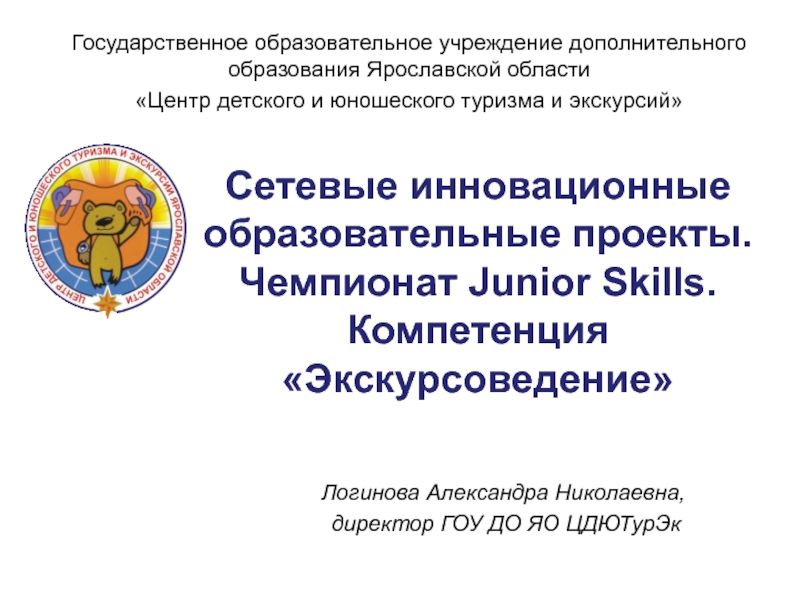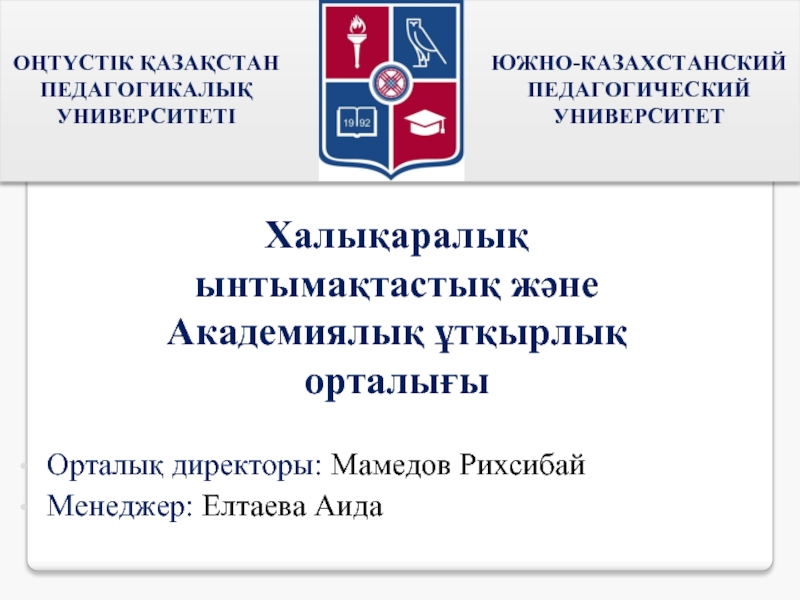Слайд 1Pat Langley
Computational Learning Laboratory
Center for the Study of Language and Information
Stanford
University, Stanford, California
http://cll.stanford.edu/
Learning Hierarchical Task Networks
from Problem Solving
Thanks to Dongkyu Choi, Kirstin Cummings, Seth Rogers, and Daniel Shapiro for contributions to this research, which was funded by Grant HR0011-04-1-0008 from DARPA IPTO and by Grant IIS-0335353 from NSF.
Слайд 2Classical Approaches to Planning
Classical
Planning
Слайд 3Planning with Hierarchical Task Networks
HTN
Planning
Слайд 4Classical and HTN Planning
Challenge: Can we unify classical and HTN planning
in a single framework?
Challenge: Can we use learning to gain the advantage of HTNs while avoiding the cost of manual construction?
Hypothesis: The responses to these two challenges are closely intertwined.
Слайд 5Mixed Classical / HTN Planning
HTN
Planning
impasse?
Classical
Planning
yes
no
Слайд 6Learning HTNs from Classical Planning
HTN
Planning
impasse?
Classical
Planning
yes
no
HTN
Learning
Слайд 7Four Contributions of the Research
Representation: A specialized class of hierarchical task
nets.
Execution: A reactive controller that utilizes these structures.
Planning: A method for interleaving HTN execution with problem solving when impasses are encountered.
Learning: A method for creating new HTN methods from successful solutions to these impasses.
Слайд 8A New Representational Formalism
Concepts: A set of conjunctive relational inference rules;
Primitive
skills: A set of durative STRIPS operators;
Nonprimitive skills: A set of HTN methods which specify:
a head that indicates a goal the method achieves;
a single (typically defined) precondition;
one or more ordered subskills for achieving the goal.
This special class of hierarchical task networks can be executed reactively but in a goal-directed manner (Nilsson, 1994).
A teleoreactive logic program consists of three components:
Слайд 9Some Defined Concepts (Axioms)
(clear (?block)
:percepts ((block ?block))
:negatives ((on ?other ?block)))
(hand-empty (
)
:percepts ((hand ?hand status ?status))
:tests ((eq ?status 'empty)))
(unstackable (?block ?from)
:percepts ((block ?block) (block ?from))
:positives ((on ?block ?from) (clear ?block) (hand-empty)))
(pickupable (?block ?from)
:percepts ((block ?block) (table ?from))
:positives ((ontable ?block ?from) (clear ?block) (hand-empty)))
(stackable (?block ?to)
:percepts ((block ?block) (block ?to))
:positives ((clear ?to) (holding ?block)))
(putdownable (?block ?to)
:percepts ((block ?block) (table ?to))
:positives ((holding ?block)))
Слайд 10Some Primitive Skills (Operators)
(unstack (?block ?from)
:percepts ((block ?block ypos ?ypos) (block
?from))
:start (unstackable ?block ?from)
:actions ((*grasp ?block) (*vertical-move ?block (+ ?ypos 10)))
:effects ((clear ?from) (holding ?block)))
(pickup (?block ?from)
:percepts ((block ?block) (table ?from height ?height))
:start (pickupable ?block ?from)
:effects ((holding ?block)))
(stack (?block ?to)
:percepts ((block ?block) (block ?to xpos ?xpos ypos ?ypos height ?height))
:start (stackable ?block ?to)
:effects ((on ?block ?to) (hand-empty)))
(putdown (?block ?to)
:percepts ((block ?block) (table ?to xpos ?xpos ypos ?ypos height ?height))
:start (putdownable ?block ?to)
:effects ((ontable ?block ?to) (hand-empty)))
Слайд 11 Some NonPrimitive Recursive Skills
(clear (?C)
:percepts ((block ?D) (block ?C))
:start (unstackable
?D ?C)
:skills ((unstack ?D ?C)))
(clear (?B)
:percepts ((block ?C) (block ?B))
:start [(on ?C ?B) (hand-empty)]
:skills ((unstackable ?C ?B) (unstack ?C ?B)))
(unstackable (?C ?B)
:percepts ((block ?B) (block ?C))
:start [(on ?C ?B) (hand-empty)]
:skills ((clear ?C) (hand-empty)))
(hand-empty ( )
:percepts ((block ?D) (table ?T1))
:start (putdownable ?D ?T1)
:skills ((putdown ?D ?T1)))
[Expanded for readability]
Teleoreactive logic programs are executed in a top-down, left-to-right manner, much as in Prolog but extended over time, with a single path being selected on each time step.
Слайд 12Interleaving HTN Execution and Classical Planning
Solve(G)
Push the goal literal G
onto the empty goal stack GS.
On each cycle,
If the top goal G of the goal stack GS is satisfied,
Then pop GS.
Else if the goal stack GS does not exceed the depth limit,
Let S be the skill instances whose heads unify with G.
If any applicable skill paths start from an instance in S,
Then select one of these paths and execute it.
Else let M be the set of primitive skill instances that have not already failed in which G is an effect.
If the set M is nonempty,
Then select a skill instance Q from M.
Push the start condition C of Q onto goal stack GS.
Else if G is a complex concept with the unsatisfied subconcepts H and with satisfied subconcepts F,
Then if there is a subconcept I in H that has not yet failed,
Then push I onto the goal stack GS.
Else pop G from the goal stack GS and store information about failure with G's parent.
Else pop G from the goal stack GS.
Store information about failure with G's parent.
This is traditional means-ends analysis, with three exceptions: (1) conjunctive goals must be defined concepts; (2) chaining occurs over both skills/operators and concepts/axioms; and (3) selected skills are executed whenever applicable.
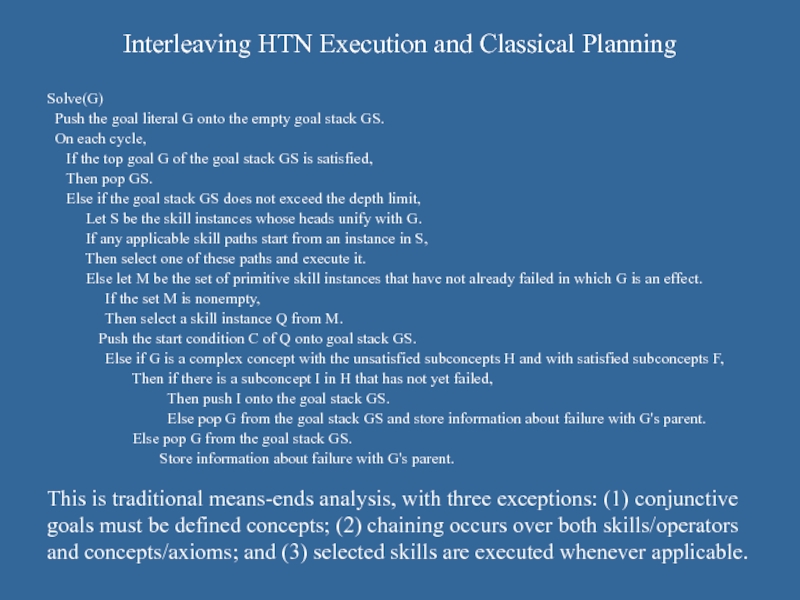
Слайд 13A Successful Planning Trace
(ontable A T)
(on B A)
(on C B)
(hand-empty)
(clear C)
(unst.
C B)
(unstack C B)
(clear B)
(putdown C T)
(unst. B A)
(unstack B A)
(clear A)
(holding C)
(hand-empty)
(holding B)
initial state
goal
Слайд 14Three Questions about HTN Learning
What is the hierarchical structure of the
network?
What are the heads of the learned clauses/methods?
What are the conditions on the learned clauses/methods?
The answers follow naturally from our representation and from our approach to plan generation.
Слайд 15Recording Results for Learning
Solve(G)
Push the goal literal G onto the
empty goal stack GS.
On each cycle,
If the top goal G of the goal stack GS is satisfied,
Then pop GS and let New be Learn(G).
If G's parent P involved skill chaining,
Then store New as P's first subskill.
Else if G's parent P involved concept chaining,
Then store New as P's next subskill.
Else if the goal stack GS does not exceed the depth limit,
Let S be the skill instances whose heads unify with G.
If any applicable skill paths start from an instance in S,
Then select one of these paths and execute it.
Else let M be the set of primitive skill instances that have not already failed in which G is an effect.
If the set M is nonempty,
Then select a skill instance Q from M, store Q with goal G as its last subskill,
Push the start condition C of Q onto goal stack GS, and mark goal G as involving skill chaining.
Else if G is a complex concept with the unsatisfied subconcepts H and with satisfied subconcepts F,
Then if there is a subconcept I in H that has not yet failed,
Then push I onto the goal stack GS, store F with G as its initially true subconcepts,
and mark goal G as involving concept chaining.
Else pop G from the goal stack GS and store information about failure with G's parent.
Else pop G from the goal stack GS.
Store information about failure with G's parent.
The extended problem solver calls on Learn to construct a new skill clause and stores the information it needs in the goal stack generated during search.
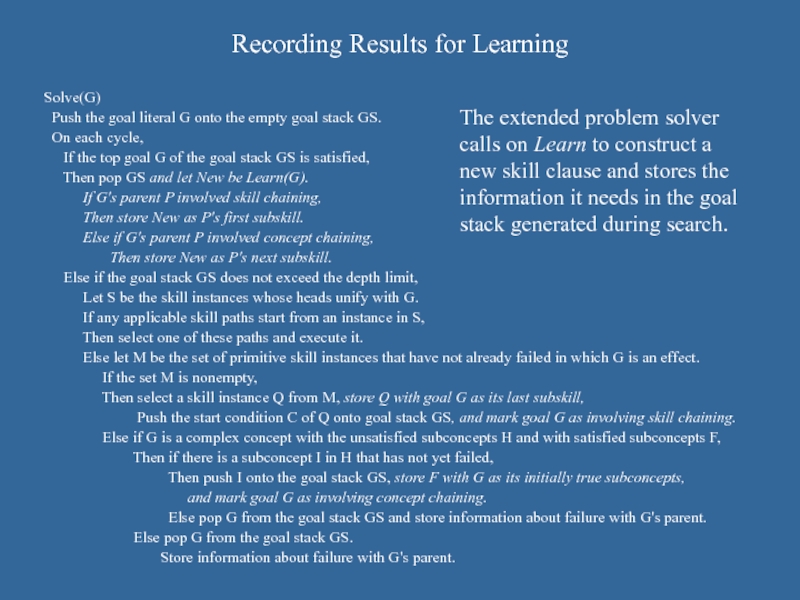
Слайд 16Three Questions about HTN Learning
What is the hierarchical structure of
the network?
The structure is determined by the subproblems solved during planning, which, because both operator conditions and goals are single literals, form a semilattice.
What are the heads of the learned clauses/methods?
What are the conditions on the learned clauses/methods?
Слайд 17
(ontable A T)
(on B A)
(on C B)
(hand-empty)
(clear C)
(unst. C B)
(unstack C
B)
(clear B)
(putdown C T)
(unst. B A)
(unstack B A)
(clear A)
(holding C)
(hand-empty)
(holding B)
1
skill chaining
Constructing Skills from a Trace
Слайд 18
(ontable A T)
(on B A)
(on C B)
(hand-empty)
(clear C)
(unst. C B)
(unstack C
B)
(clear B)
(putdown C T)
(unst. B A)
(unstack B A)
(clear A)
(holding C)
(hand-empty)
(holding B)
1
2
skill chaining
Constructing Skills from a Trace
Слайд 19
(ontable A T)
(on B A)
(on C B)
(hand-empty)
(clear C)
(unst. C B)
(unstack C
B)
(clear B)
(putdown C T)
(unst. B A)
(unstack B A)
(clear A)
(holding C)
(hand-empty)
(holding B)
1
3
2
concept chaining
Constructing Skills from a Trace
Слайд 20
(ontable A T)
(on B A)
(on C B)
(hand-empty)
(clear C)
(unst. C B)
(unstack C
B)
(clear B)
(putdown C T)
(unst. B A)
(unstack B A)
(clear A)
(holding C)
(hand-empty)
(holding B)
1
3
2
4
skill chaining
Constructing Skills from a Trace
Слайд 21 Learned Skills After Structure Determined
( (?C)
:percepts ((block ?D) (block ?C))
:start
:skills ((unstack ?D ?C)))
( (?B)
:percepts ((block ?C) (block ?B))
:start
:skills ((unstackable ?C ?B) (unstack ?C ?B)))
( (?C ?B)
:percepts ((block ?B) (block ?C))
:start
:skills ((clear ?C) (hand-empty)))
( ( )
:percepts ((block ?D) (table ?T1))
:start
:skills ((putdown ?D ?T1)))
Слайд 22Three Questions about HTN Learning
What is the hierarchical structure of
the network?
The structure is determined by the subproblems solved during planning, which, because both operator conditions and goals are single literals, form a semilattice.
What are the heads of the learned clauses/methods?
The head of a learned clause is the goal literal that the planner achieved for the subproblem that produced it.
What are the conditions on the learned clauses/methods?
Слайд 23 Learned Skills After Heads Inserted
(clear (?C)
:percepts ((block ?D) (block ?C))
:start
:skills ((unstack ?D ?C)))
(clear (?B)
:percepts ((block ?C) (block ?B))
:start
:skills ((unstackable ?C ?B) (unstack ?C ?B)))
(unstackable (?C ?B)
:percepts ((block ?B) (block ?C))
:start
:skills ((clear ?C) (hand-empty)))
(hand-empty ( )
:percepts ((block ?D) (table ?T1))
:start
:skills ((putdown ?D ?T1)))
Слайд 24Three Questions about HTN Learning
What is the hierarchical structure of
the network?
The structure is determined by the subproblems solved during planning, which, because both operator conditions and goals are single literals, form a semilattice.
What are the heads of the learned clauses/methods?
The head of a learned clause is the goal literal that the planner achieved for the subproblem that produced it.
What are the conditions on the learned clauses/methods?
If the subproblem involved skill chaining, they are the conditions of the first subskill clause.
If the subproblem involved concept chaining, they are the subconcepts that held at the outset of the subproblem.
Слайд 25 Learned Skills After Conditions Inferred
(clear (?C)
:percepts ((block ?D) (block ?C))
:start (unstackable ?D ?C)
:skills ((unstack ?D ?C)))
(clear (?B)
:percepts ((block ?C) (block ?B))
:start [(on ?C ?B) (hand-empty)]
:skills ((unstackable ?C ?B) (unstack ?C ?B)))
(unstackable (?C ?B)
:percepts ((block ?B) (block ?C))
:start [(on ?C ?B) (hand-empty)]
:skills ((clear ?C) (hand-empty)))
(hand-empty ( )
:percepts ((block ?D) (table ?T1))
:start (putdownable ?D ?T1)
:skills ((putdown ?D ?T1)))
Слайд 26Learning an HTN Method from a Problem Solution
Learn(G)
If the goal
G involves skill chaining,
Then let S1 and S2 be G's first and second subskills.
If subskill S1 is empty,
Then return the literal for clause S2.
Else create a new skill clause N with head G,
with S1 and S2 as ordered subskills, and
with the same start condition as subskill S1.
Return the literal for skill clause N.
Else if the goal G involves concept chaining,
Then let {Ck+1, ..., Cn} be G's initially satisfied subconcepts.
Let {C1, ..., Ck} be G's stored subskills.
Create a new skill clause N with head G,
with {Ck+1, ..., Cn} as ordered subskills, and
with the conjunction of {C1, ..., Ck} as start condition.
Return the literal for skill clause N.
Слайд 27Creating a Clause from Skill Chaining
Problem
Solution
New
Method
Слайд 28Creating a Clause from Concept Chaining
Problem
Solution
New
Method
Слайд 29Important Features of Learning Method
it occurs incrementally from one experience at
a time;
it takes advantage of existing background knowledge;
it constructs the hierarchies in a cumulative manner.
Our approach to learning HTNs has some important features:
In these ways, it is similar to explanation-based approaches to learning from problem solving.
However, the method for finding conditions involves neither analytic or inductive learning in their traditional senses.
Слайд 30An In-City Driving Environment
Our focus on learning for reactive control comes
from an interest in complex physical domains, such as driving a vehicle in a city.
To study this problem, we have developed a realistic simulated environment that can support many different driving tasks.
Слайд 31 Skill Clauses Learning for In-City Driving
parked (?ME ?G1152)
:percepts ( (lane-line
?G1152) (self ?ME))
:start ( )
:skills ( (in-rightmost-lane ?ME ?G1152)
(stopped ?ME))
in-rightmost-lane (?ME ?G1152)
:percepts ( (self ?ME) (lane-line ?G1152))
:start ( (last-lane ?G1152))
:skills ( (driving-in-segment ?ME ?G1101 ?G1152))
driving-in-segment (?ME ?G1101 ?G1152)
:percepts ( (lane-line ?G1152) (segment ?G1101) (self ?ME))
:start ( (steering-wheel-straight ?ME))
:skills ( (in-lane ?ME ?G1152)
(centered-in-lane ?ME ?G1101 ?G1152)
(aligned-with-lane-in-segment ?ME ?G1101 ?G1152)
(steering-wheel-straight ?ME))
Слайд 32Learning Curves for In-City Driving
Слайд 33Transfer Studies of HTN Learning
Because we were interested in our method’s
ability to transfer its learned skills to harder problems, we:
created concepts and operators for Blocks World and FreeCell;
let the system solve and learn from simple training problems;
asked the system to solve and learning from harder test tasks;
recorded the number of steps taken and solution probability;
as a function of the number of transfer problems encountered;
averaged the results over many different problem orders.
The resulting transfer curves revealed the system’s ability to take advantage of prior learning and generalize to new situations.
Слайд 34Transfer Effects in the Blocks World
On 20-block tasks, there is no
difference in solved problems.
20 blocks
Слайд 35Transfer Effects in the Blocks World
However, there is difference in the
effort needed to solve them.
20 blocks
Слайд 36FreeCell Solitaire
FreeCell is a full-information card game that, in most cases,
can be solved by planning; it also has a highly recursive structure.
Слайд 37Transfer Effects in FreeCell
On 16-card FreeCell tasks, prior training aids solution
Слайд 38Transfer Effects in FreeCell
However, it also lets the system solve problems
with less effort.
16 cards
Слайд 39Transfer Effects in FreeCell
On 20-card tasks, the benefits of prior training
are much stronger.
20 cards
Слайд 40Transfer Effects in FreeCell
However, it also lets the system solve problems
with less effort.
20 cards
Слайд 41Where is the Utility Problem?
Many previous studies of learning and planning
found that:
learned knowledge reduced problem-solving steps and search
but increased CPU time because it was specific and expensive
We have not yet observed the utility problem, possibly because:
the problem solver does not chain off learned skill clauses;
our performance module does not attempt to eliminate search.
If we encounter it in future domains, we will collect statistics on clauses to bias selection, like Minton (1988) and others.
Слайд 42Related Work on Planning and Execution
problem-solving architectures like Soar and Prodigy
Nilsson’s
(1994) notion of teleoreactive controllers
execution architectures that use HTNs to structure knowledge
Nau et al.’s encoding of HTNs for use in plan generation
Our approach to planning and execution bears similarities to:
These mappings are valid but provide no obvious approach to learning HTN structures from successful plans.
Erol et al.’s (1994) complexity analysis of HTN planning
Barrett and Weld’s (1994) use of HTNs for plan parsing
Other mappings between classical and HTN planning come from:
Слайд 43Related Research on Learning
production composition (e.g., Neves & Anderson, 1981)
macro-operator formation
(e.g., Iba, 1985)
explanation-based learning (e.g., Mitchell et al., 1986)
chunking in Soar (Laird, Rosenbloom, & Newell, 1986)
Our learning mechanisms are similar to those in earlier work on:
which also learned decomposition rules from problem solutions.
Marsella and Schmidt’s (1993) REAPPR
Ruby and Kibler’s (1993) SteppingStone
Reddy and Tadepalli’s (1997) X-Learn
But they do not rely on analytical schemes like goal regression, and their creation of hierarchical structures is closer to that by:
Слайд 44The ICARUS Architecture
Long-Term
Conceptual
Memory
Long-Term
Skill Memory
Short-Term
Conceptual
Memory
Goal/Skill
Stack
Categorization
and Inference
Skill
Execution
Perception
Environment
Perceptual
Buffer
Problem Solving
Skill Learning
Motor
Buffer
Skill
Retrieval
Слайд 45Hierarchical Structure of Long-Term Memory
concepts
skills
Each concept is defined in terms of
other concepts and/or percepts.
Each skill is defined in terms of other skills, concepts, and percepts.
ICARUS organizes both concepts and skills in a hierarchical manner.
Слайд 46
Interleaved Nature of Long-Term Memory
For example, the skill highlighted here refers
directly to the highlighted concepts.
ICARUS interleaves its long-term memories for concepts and skills.
Слайд 47Recognizing Concepts and Selecting Skills
concepts
skills
Concepts are matched bottom up, starting from
percepts.
Skill paths are matched top down, starting from intentions.
ICARUS matches patterns to recognize concepts and select skills.
Слайд 48Directions for Future Work
Despite our initial progress on structure learning, we
should still:
evaluate approach on more complex planning domains;
extend method to support HTN planning rather than execution;
generalize the technique to acquire partially ordered skills;
adapt scheme to work with more powerful planners;
extend method to chain backward off learned skill clauses;
add technique to learn recursive concepts for preconditions;
examine and address the utility problem for skill learning.
These should make our approach a more effective tool for learning hierarchical task networks from classical planning.
Слайд 49relies on a new formalism – teleoreactive logic programs – that
identifies heads with goals and has single preconditions;
executes stored HTN methods when they are applicable but resorts to classical planning when needed;
caches the results of successful plans in new HTN methods using a simple learning technique;
creates recursive, hierarchical structures from individual problems in an incremental and cumulative manner.
We have described an approach to planning and execution that:
This approach holds promise for bridging the longstanding divide between two major paradigms for planning.
Concluding Remarks
